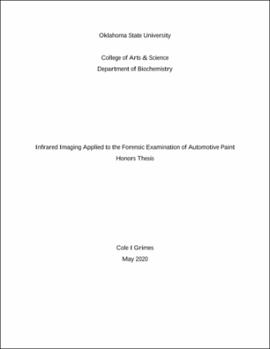| dc.contributor.author | Grimes, Cole I. | |
| dc.date.accessioned | 2021-04-20T13:53:23Z | |
| dc.date.available | 2021-04-20T13:53:23Z | |
| dc.date.issued | 2020-05-08 | |
| dc.identifier | oksd_grimes_HT_2020 | |
| dc.identifier.uri | https://hdl.handle.net/11244/329432 | |
| dc.description.abstract | In a vehicle related fatality, paint fragments in the form of a chip are often transferred from the vehicle to the clothing of a pedestrian or an object such as a post. To analyze these paint fragments, a new approach to automotive paint analysis has been developed which is described in this honor's thesis. The new approach to forensic automotive paint analysis involves cross sectioning the paint chip with a microtome and then collecting infrared spectra from the entire chip in a single analysis by scanning across each layer using a transmission or attenuated total reflection (ATR) infrared microscope. After the spectral data from the microscope is collected, the data is then subject to decatenation using alternating least squares to extract the "pure" infrared (IR) spectrum of each layer from the image. Cross-sectioning the paint sample eliminates the need to analyze each paint layer separately and is faster than current methods which involve hand sectioning each layer. The use of spectal imaging can ensure that an IR spectrum of each paint layer is "pure" and is not a blend of multiple layers. The benefit of not collecting a mixed IR spectrum is higher quality matches when performing searches against the paint data query (PDQ) or other forensic automotive paint databases. Using this proposed approach, IR spectra of the clear coat, color coat, surfacer-primer, and e-coat layers were collected in a single analysis from a multi-layered automotive paint chip or paint smear using a transmission infrared imaging microscope. Decatenation of the spectral image as represented by a line map was achieved using alternating least squares. The successful spectral reconstructions of each layer allowed us to quantify the discrimination power of the original manufacturer's automotive paint system by way of a library search. The research described in this honors thesis will serve to quantify the general discrimination power of automotive paint comparisons involving both paint chips and paint smears and further efforts to succinctly communicate the significance of this evidence to the courts. This research will also ensure that analytical techniques used by paint examiners in forensic laboratories will remain current with respect to modern automotive paint systems. | |
| dc.format | application/pdf | |
| dc.language | en_US | |
| dc.rights | Copyright is held by the author who has granted the Oklahoma State University Library the non-exclusive right to share this material in its institutional repository. Contact Digital Library Services at lib-dls@okstate.edu or 405-744-9161 for the permission policy on the use, reproduction or distribution of this material. | |
| dc.title | Infrared imaging applied to the forensic examination of automotive paint | |
| osu.filename | oksd_grimes_HT_2020.pdf | |
| osu.accesstype | Open Access | |
| dc.type.genre | Honors Thesis | |
| dc.type.material | Text | |
| dc.contributor.director | Lavine, Barry | |
| dc.contributor.facultyreader | Materer, Nick | |
| thesis.degree.discipline | Chemistry | |
| thesis.degree.grantor | Oklahoma State University | |
